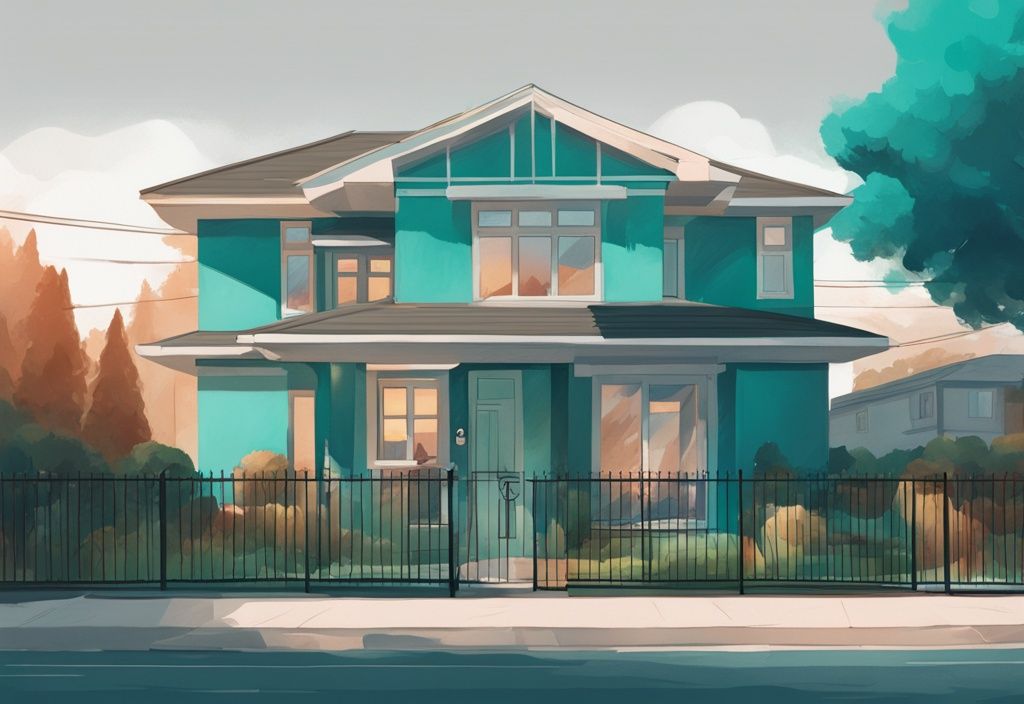Ever thought about why SFH or Single-Family Homes are the symbol of the American dream? Ever wondered what makes them such a lucrative investment? As a seasoned realtor, I tangled with these questions early on in my career. Now, let me simplify it for you.
I’m sharing my ‘go-to’ guide on SFH in real estate, providing you with a crystal-clear understanding of this common yet crucial term. Your ‘aha’ moment is about to unlock as I break down the challenges, benefits, and potential sandwiched within the realm of SFHs.
So, plant your feet in the exciting field of real estate, as we delve into the dynamics of Single-Family Homes, an undisputed cornerstone for both homeowners and investors like you. Let’s unwrap the mystery together.
Introductory Understanding: SFH in Real Estate
Exploring the Meaning of Single-Family Home (SFH)
In the realm of real estate, the term SFH stands for Single-Family Home. It refers to a residence uniquely designed to accommodate a single household or family. Unlike other housing types, a Single-Family Home is a freestanding structure, providing a distinct living experience.
A critical feature of a Single-Family Home is its freestanding structure. This means the house stands on its own, not sharing walls, floors, or other living spaces with neighboring units. Imagine having the liberty to play music, host gatherings, or simply unwind, all within the privacy of your own walls – that’s the beauty of a Single-Family Home.
Single-Family Homes are emblematic of the American dream of homeownership, a sentiment echoed in discussions about the value of owning a home over renting in the United States, as highlighted in a recent article on the importance of homeownership in achieving this dream. Read more here. They offer more than just a place to live; they represent a personal oasis where you can plant roots, create cherished memories, and fully control your living environment. Think of it as having the freedom to paint your walls any color or design the perfect garden without external restrictions.
- A Single-Family Home in real estate isn’t just a type of building; it’s a lifestyle choice.
- Designed to house only one family, these homes offer exclusive living arrangements without shared walls or communal spaces.
- The architectural design ensures a detached structure, often featuring a private yard or outdoor space that enhances your living experience.
- With no shared structural elements, Single-Family Homes provide maximum privacy and a sense of belonging within residential neighborhoods.
Understanding what is SFH in real estate illuminates the unique features and allure of Single-Family Homes. These homes are highly sought after by those craving independent and personalized living spaces. They offer the perfect blend of privacy, freedom, and community connection – making them an ideal choice for individuals and families alike.
Defining Single-Family Homes in Real Estate Context
A Single-Family Home (SFH) in real estate is a standalone residential structure designed to house one household or family, offering a unique living experience marked by privacy and independence. Unlike multi-family units or attached homes, an SFH is entirely detached from other dwellings. This separation means that there are no shared walls, floors, or common utilities with adjacent houses, which is a significant factor for those looking for more personal space.
SFHs commonly include private yards or outdoor spaces. These areas provide residents with the opportunity to enjoy personal outdoor activities, gardening, or simply having a space for children to play. This element of private outdoor space is an appealing aspect for many potential homeowners, as it adds an additional level of comfort and utility to the property.
Ownership of a Single-Family Home typically lies with an individual, family, or investor who also owns the land the home is built on. This ownership can mean greater control over the property, as the owner is responsible for all aspects of maintenance, landscaping, and any modifications. This responsibility ensures that the owner can make changes and improvements according to their personal tastes and requirements, without needing approval from other property owners, although certain local regulations and HOA guidelines may apply.
These homes are usually situated in residential neighborhoods, which often provide a stable environment and foster a sense of community. Living in a Single-Family Home means being part of a neighborhood where long-term residency is common, creating opportunities for building lasting relationships with neighbors and contributing to a cohesive community feel. This stability is another attractive aspect for both homeowners and investors looking to maintain or enhance property values over time.
With its focus on individual ownership and self-contained living, the concept of what is SFH in real estate underscores its appeal. For families and investors alike, the privacy, control over property, personal outdoor space, and community stability make Single-Family Homes a compelling choice in the housing market.
Recognition Factors: How to identify a SFH
Identifying a Single-Family Home (SFH) involves looking for a few key characteristics:
- Standalone Structure: SFHs are completely detached from other residences, ensuring no shared walls or floors.
- Private Yard: Look for homes with a dedicated outdoor space solely for the use of the household.
- Individual Ownership: The property, including the land it sits on, is owned by one party without shared ownership.
- Neighborhoods: Typically found in residential zones known for fostering stable, community-oriented environments.

By keeping these factors in mind, you can confidently identify a Single-Family Home and appreciate the unique benefits it offers in the real estate market.
The Upsides of SFH Ownership
Key Benefits of Living in Single-Family Homes
Single-Family Homes (SFHs) offer several compelling advantages, making them a popular choice for homeownership. Understanding what an SFH is in real estate involves recognizing not just the structural qualities but also the lifestyle benefits it provides.
Firstly, an SFH offers a significant degree of privacy and independence. The absence of shared walls, floors, or ceilings ensures that residents have their personal space without noise disturbances from neighbors. This adds to the peaceful living environment that is often a key attraction for families and individuals alike.
Secondly, having a private entrance and exit is another safety and convenience feature inherent to SFHs. Unlike multi-family units or apartments, there’s no need for shared access points, which contributes to both safety and the ease of coming and going as you please.
Additionally, most SFHs come with their own yard or garden space. This outdoor area serves as an invaluable space for recreation, gardening, and personal relaxation. It’s a sanctuary where children can play safely and adults can unwind or entertain guests, enhancing the overall quality of life.
Another significant benefit of SFHs is the appeal they hold for long-term tenants. Families and individuals looking for stability and a sense of community are often drawn to these types of homes. This means lower tenant turnover rates, which translates to less wear and tear and fewer disruptions for property owners.
Finally, owning an SFH allows for extensive customization. From interior design changes to landscaping, homeowners have the freedom to modify their property to reflect their personal style and functional needs. This level of control is seldom possible in rental or multi-family living situations.
In conclusion, the comprehensive understanding of what an SFH is in real estate extends beyond its physical attributes to include significant lifestyle benefits. The privacy, safety, outdoor space, long-term tenant stability, and customization potential make Single-Family Homes an attractive option for many.
What Makes Single Family Homes Attractive to Investors
A Look into the Investment Potential of SFHs
Single-Family Homes, often referred to by the acronym SFH in real estate, are a noteworthy investment option for many reasons. First and foremost, they consistently provide a steady rental income. Families seeking a traditional lifestyle often favor these homes, making them a high-demand rental option. This demand ensures that real estate investors can rely on consistent occupancy rates and predictable rental yields.
Managing an SFH is generally more straightforward compared to larger multi-family properties. Typically, only one HVAC system, roof, and yard need maintenance, reducing the complexity and cost of property management. This simplicity appeals to both new and seasoned investors looking for manageable investments.
Another compelling factor is the potential for property appreciation. SFHs have the ability to increase in value over time, often at higher rates than other types of residential properties. When sold, these properties can yield significant capital gains, adding another layer of financial benefit beyond rental income.
Diverse portfolios are essential in real estate investment, and including SFHs provides important diversification. By spreading risk across different property types, investors are less vulnerable to market fluctuations affecting any single segment of their portfolio. Understanding factors like external obsolescence in real estate is crucial for maximizing investment returns over time. SFHs are typically less volatile, adding stability to an investor’s assets.

Furthermore, SFHs offer flexibility in exit strategies. Investors can choose to sell the property, continue renting it, or even use it for personal purposes in the future. This range of options adds to the versatility and attractiveness of SFHs as a long-term investment.
The resilience of rental income streams from SFHs is a significant draw for institutional investors and pension funds. The dependable rental income duration makes these homes a reliable component in investment strategies focused on steady returns. Overall, SFHs provide a balance of stable income, potential for appreciation, manageable maintenance, and flexible exit strategies, making them an appealing choice for real estate investors.
Navigating the SFH Rental Market
Venturing into the SFH rental market requires an understanding of why Single-Family Homes (SFHs) hold such a special place for families. Let’s break this down.
Why Families Prefer Single-Family Homes: A Rental Perspective
Understanding what is SFH in real estate is crucial when examining the rental choices of families. SFHs offer a unique level of privacy, largely thanks to their detached nature, making them highly sought-after. Imagine enjoying your own backyard with no shared walls – it’s a dream for many families seeking personal space away from the hustle and bustle of multi-family properties.
Another factor making SFHs so appealing is their typical location. These homes are frequently nestled in neighborhoods renowned for excellent schools, beautiful parks, and various community amenities. These attributes are essential for families, offering a safe, nurturing environment that’s perfect for raising children. It’s like having a small, supportive village right at your doorstep.
A major perk of renting an SFH is access to private outdoor spaces like yards and gardens. These areas not only improve the quality of living but also provide a secure spot for various family activities. Whether it’s gardening, playing with the kids, or hosting a barbecue, these outdoor spaces cater directly to the lifestyle needs of family tenants. It’s a little slice of nature’s paradise right at home.
SFHs also promote a strong sense of community and stability, which families highly value. Staying in one place for an extended period helps create a consistent and reliable living situation, crucial for family planning and daily routines. It’s the difference between feeling like a temporary guest and truly making a house a home.
Lastly, SFHs are more suited for long-term rentals compared to other property types. Families looking for a permanent solution can find comfort and consistency here. By fostering a stable environment that encourages community connections and personal space, SFHs remain the top choice for family rentals, making them the cornerstone of the rental market for many families.
Overcoming Challenges of SFH Investment
The Risks and How to Handle Them
Investing in Single-Family Homes (SFHs) presents distinct challenges, but understanding these obstacles is the first step to overcoming them. Recognizing the inherent risks can equip investors to manage their properties more effectively and maximize returns.
One significant challenge of SFH investment is the extensive hands-on maintenance it often requires. Unlike multi-family properties, where maintenance can be consolidated, SFHs require individual attention, which can prove both time-consuming and costly. To address this, investors might consider setting aside a maintenance budget and scheduling regular inspections to prevent small issues from becoming extensive repairs.
Another concern involves the typically lower rental income yield of SFHs compared to multi-family properties. Multi-family homes generate income from multiple units, whereas SFHs rely on a single tenant or family. This disparity can be managed by setting competitive rental prices and ensuring that your property is located in a desirable area. High-demand locations tend to attract tenants willing to pay premium rents.
Financial losses due to vacancy are another risk as SFHs do not have the benefit of multiple units to offset costs when unoccupied. To mitigate this, thorough tenant screening and fostering strong tenant relationships can lead to longer leases and fewer vacancies. Offering incentives for long-term leases, such as minor rent reductions or property upgrades, can also encourage tenant retention.
Market conditions heavily influence property values, causing potential value fluctuations. Market research and staying informed of local real estate trends are crucial practices. Employing tactics like refinancing or leveraging a 1031 exchange can help stabilize investments during market volatility. Additionally, short-term sales can provide liquidity and prevent significant losses when long-term value retention is uncertain.
Proper tenant screening cannot be overstated; it’s pivotal for maintaining tenant stability and reducing turnover. Conducting credit checks, verifying employment, and reviewing rental histories help ensure reliable tenants.
SFHs in homeowners associations (HOA) can involve extra standards and fees, but these associations often help maintain property values by enforcing community standards. Understanding HOA rules and factoring HOA fees into your investment calculations is crucial. A well-managed HOA can reduce your property maintenance workload and contribute positively to property value appreciation.

By recognizing these challenges and employing strategic management and mitigation techniques, investors can navigate the complexities of SFH investment and harness its full potential. Effective risk management ensures more stable returns and a smoother investment journey.
Decoding What SFHs Mean in Real Estate
An SFH, or Single-Family Home, stands as a cornerstone of the American dream. Whether you’re buying your first home or eyeing a lucrative investment, understanding the ins and outs of SFHs is crucial. Dive into the essential questions and answers about Single-Family Homes and discover why they continue to be a top choice in the real estate market.
FAQ: Your Burning Questions Answered
-
How does an SFH differ from a multi-family home?
Picture an SFH as a cozy standalone house where you don’t have to share walls or utilities. It’s all yours, offering a sense of privacy that’s hard to match. In contrast, multi-family homes are like apartment complexes within one building, hosting several units for different families. Think of it as choosing between your own cottage and an apartment in a shared building. -
What are the key benefits of owning an SFH?
Imagine having a little oasis where you can paint the walls any color you like, plant a garden, or build a doghouse without needing someone else’s approval. That’s one of the joys of owning an SFH. You get high privacy, the potential to see your property’s value climb, and total control over maintenance. Whether it’s installing a new deck or just fixing a leaky faucet, you call the shots. -
What makes SFHs a good investment?
Think of it like planting a tree—you nurture it and it grows steadily over time. SFHs are often sought after by families, meaning there’s a reliable demand. Their property values can grow significantly, often more steadily than stocks. Plus, managing an SFH is straightforward, and if you decide to sell, there are usually many takers. It’s about stability and simplicity. -
What are common risks associated with SFH investments?
It’s not all roses and rainbows. Maintenance costs can add up, and while multi-family properties might offer higher rental yields, SFHs don’t always generate as much rental income. Vacancies and market swings can also be a concern. Staying on top of market trends and keeping the property in tip-top shape can help mitigate these risks. -
Are there financing advantages for buying SFHs?
Absolutely! SFHs often qualify for a variety of loan incentives and mortgage insurance through government-backed programs. This means you might get a better deal on your mortgage, making it easier for more people to afford their dream home or add to their investment portfolio. -
Can SFHs be used for short-term rentals?
You bet! SFHs make excellent candidates for platforms like Airbnb. They offer that home-like comfort and privacy that travelers love. If you’re looking to dip your toes into short-term rentals, an SFH could be the perfect start. -
How does the presence of an HOA affect SFH ownership?
Homeowners Associations (HOAs) can be a double-edged sword. On the plus side, they help maintain community standards, which can keep your property value stable or even boost it. On the flip side, they come with fees and rules. It’s like having a helpful but strict neighbor who sets the community’s tone. -
Are SFHs a stable long-term investment?
Generally, yes. SFHs often provide steady capital appreciation and reliable rental income, particularly in sought-after neighborhoods. Their enduring appeal makes them a solid part of any diversified investment portfolio, much like a well-worn recipe that always delivers delicious results.
Hi, I’m Alex Harper, a real estate expert with over ten years of experience in property management and legal advice. My passion is making the often complicated world of real estate understandable. I share practical tips and simple solutions to help you make better decisions – whether you’re buying a home, renting or just want to learn more about the industry. With my knowledge and experience, I want you to feel well-informed and confident in your real estate projects. Let’s tackle this together!




